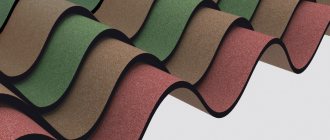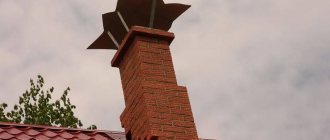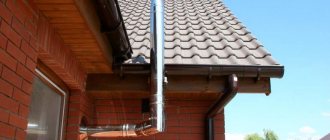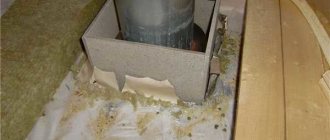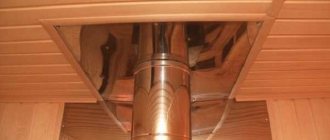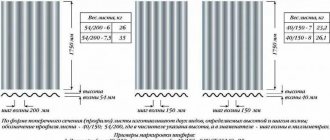- Roofing from corrugated sheets How to remove a rectangular chimney pipe
- Ondulin coating
- Extraction through a soft roof
- Passage through ondulin
- Elastic penetrations
- What is the goal?
- Pipe waterproofing Basic installation work
Objects that have a heating function from a boiler, stove or fireplace require normal exhaust of smoke to the outside, which is necessary to maintain the protection and safety of residents. Therefore, it is extremely important to know how to make a chimney pipe pass through the roof and roofing, taking into account all standards.
Basic Rules
If your home has heating, you will need to create optimal conditions for removing flue gases. There are several ways to remove the pipe depending on the installation location. Its choice is influenced by many factors, and the chimney can be installed:
- in the ridge itself;
- at a distance from him.
Each of the described methods has its own differences and features, but preference is given to installation according to the second option. To maintain the required draft force, the total height of the smoke channel must correspond to the limits of 5-10 m.
Features of this design
Sandwich is a good option for a chimney pipe with insulation. Insulation provides you with the following advantages:
- the possibility of functionality of the chimney pipe when located in a zone of low temperature conditions;
- provides the pipe with the necessary fireproof properties (inside the building).
Standard versions of such chimneys have an external galvanized coating. There are also options made of stainless steel, as well as painted in any color suitable for you.
Existing versions of sandwiches made of stainless steel are covered with a special protective film on the outside. The main thing is to remember to remove it before using the chimney for its intended purpose. There are also special adapters on sale that you will need when connecting the boiler and pipe. Be careful when choosing elements for a sandwich chimney.
Scheme of a sandwich pipe.
The necessary tools for work are:
How to protect your roof from fire
To do this, you need to consider two points:
- Passage through walls and ceilings. Here it is necessary to use polyurethane foam with mineralite, since the outer pipe of the sandwich heats up to a temperature of 200*.
- When passing through the roof, roof trim and all other associated elements are required.
According to the standards, the minimum permissible distance between the chimney and load-bearing beams or rafters should be 130-250 mm. The inside of the structure is filled with heat-resistant material.
You can find passage diagrams in the Ferrum catalog in the “advertising and printing products” section of the website.
Master flush
This penetration can be applied to any type of roof - slate, tile, metal roof, asphalt or tile.
Ideal for sealing stove and fireplace chimneys.
Used for straight roofs and for sloped roofs.
This type of product is an excellent combination of price and quality.
Master Flash is distinguished by high professional reliability and functionality - this is achieved through the use of high-quality materials for use.
The main feature of this penetration is the use of reinforced polymer rubber, which can withstand heavy loads (temperatures up to 138 degrees).
Polymer rubber does not become more flexible due to heat.
Passage node
One option is to pass through the ridge.
But most often, the installation of a chimney pipe through the roof and roofing is carried out not through the ridge, but at a distance from it. According to SNiP requirements:
- The total length of the smoke channel must be at least 5 m. The only exceptions are houses that do not have attics, but subject to the presence of stable draft.
- The height of the chimney above the roof is at least 0.5 m.
- The chimney rises half a meter or more above the ridge. But if the horizontal distance between it and the ridge ridge does not exceed 105 cm.
- The mouth should be level with the ridge or higher, when the horizontal width is in the range of 1.5 - 3.0 m.
- The chimney outlet must be no lower than the line laid from the ridge towards the eaves overhang at a slope of 10º relative to the horizon.
The disadvantage is the need to compare the height of the chimney, which leads to additional costs. Professionals do not recommend doing it through the valley due to the fact that snow deposits often accumulate in such places, thereby compromising the waterproofing and causing leaks. There are also difficulties in organizing the box. Localizing the chimney in the lower section of the slope also has a significant disadvantage - the likelihood of damage when snow melts.
The installation work is also influenced by the material that forms the basis of the chimney pipe. This can be a metal, brick or ceramic base. Each of the listed options has a different combustion temperature, which you need to know when creating a project. Based on the pipe cross-section, the outlet can be shaped like a square, circle, rectangle or oval. Knowing how to properly vent a chimney through the roof, its installation is carried out in three successive stages, carried out by a specialized specialist:
- Additional rafters are installed on the sides.
- Laying horizontal beams at a distance identical to this hole (calculated according to SNiP and corresponds to the range of 140-250 mm).
- Filling the inner surface of the box with non-flammable insulation material.
To prevent disruption of normal ventilation, it is recommended to install a separate ventilation system.
Fire safety precautions when using MASTER FLASH
MASTER FLASH made of silicone can withstand temperatures up to +300 degrees Celsius. This is quite enough to seal a sandwich pipe and, in many cases, a chimney made of asbestos-cement pipe.
The passage through the metal tile is sealed using a Master Flash penetration. Additionally used bitumen tape
As for the metal mono-pipe, in these cases it is possible to use MASTER FLASH in cases where the length of the chimney from the stove to the passage through the roof is at least 3 meters. As a rule, in this situation the temperatures will not be critical, but if not, then thermal insulation of the area that passes through the roofing pie is necessary.
Smoke exhaust outlet through various types of roofing
Below are recommendations for installing a smoke exhaust duct depending on the roof material.
Tile roofing
In this option, to process the passage, professionals resort to the use of corrugated, self-adhesive, sheet aluminum or lead.
Exiting a pipe with a cross-section in the shape of a square or rectangle
If the smoke exhaust hole has a brick base, then due to non-standard dimensions, before removal, a small part of the covering sheets must be removed or cut to a larger size. To ensure waterproofing, elastic tapes with an adhesive base are used. They are glued by a specialist to the pipe base and roof sheathing. The upper edge is secured with a metal strip, and the existing connections are sealed with a sealed substance.
To prevent precipitation, it is recommended to install an additional tie.
Passage of a round chimney through the roof
This is achieved thanks to a special cap, which is responsible for the smoke exhaust hole. A small and even hole is made in the coating, according to the pipe dimensions. A master flush is put on it, and the existing connections are sealed with a sealed substance.
Final works
Cutting a chimney pipe on the ceiling or roof with your own hands is finished. All that remains is to dry the oven. But before that, we check the draft in the pipe. To do this, we bring the torch to the open door of the firebox; if the flame draws inward, the draft is normal. If there is insufficient ventilation, you will need to remove construction debris from the pipes and only then proceed to the next stage of the final.
We put no more than 3 kg of firewood in the firebox and set fire to it. During the first burning of wood, grease, dirt and paint materials will burn off from the surfaces of the stove, and moisture will be removed from the bricks. Therefore, we recommend opening windows and doors.
After the surfaces have cooled, we dry the stove a second time and check all the joints and the chimney itself for leaks and that there are no leaks of gases into the room. We eliminate possible malfunctions and only after the final check can we begin to operate the furnaces.
Only by qualitatively completing the main stages of work and carefully checking the finished chimney, you will be able to protect your home from fires and inhale the fragrant smell of burning wood, and not carbon monoxide pouring out of the cracks of the chimney.
Video material: tightness of a brick chimney through a metal tile
Corrugated roofing
This is a relevant material, often used in construction work. However, when using it, there is a risk of leakage, especially if technical rules are not followed. To prevent this outcome, it is recommended to place it in a vertical position. The roof hole is made with a grinder, but it is necessary to ensure that the resulting corrugated sheet does not have nicks or other irregularities.
How to remove a rectangular chimney pipe
In this situation, professionals recommend using galvanized sheet:
- Cutting four strips for further mounting on each side.
- Laying from the bottom edge to the cornice.
- Attach the strips and bottom fastening to the sheathing.
- Ensure tightness.
Exhaust of a chimney with a cross-section in the shape of a circle
In this case, installing a chimney through the roof requires rolled bitumen insulation or foil tape of the same name. After this, a penetration is installed, glued to the sheathing, and sealed with a heat-resistant sealant. If it is made of a rubber base, there is an increased risk of melting, so it is worth placing a clamp and gasket underneath that can withstand relatively high temperatures.
Fighting joint leaks
To create the maximum possible tightness of the junction of the roofing material and the pipe at the points of contact, an internal apron is made using the lower strips.
Installation of a chimney passage through the roof.
To make an internal apron, you need the following tools:
- marker;
- long metal ruler;
- grinder with a disk 2 mm thick;
- pliers;
- hammer.
In order to do this, the plank is applied to the walls of the chimney pipe, making marks for the top of the plank. The next step is to punch a groove along the previously marked line.
Installation of the inner apron should start from the bottom wall. The edge of the apron is inserted into the groove, after which it is installed on the remaining walls. The overlap should be 15 cm. Then the edge of the film inserted into the groove is sealed. Having trimmed the lower strips, they are installed and then secured with self-tapping screws.
After installing the lower apron, you can begin installing the tie, which is a sheet of waterproofing material placed under the elements of the inner apron from below. The main function of a tie is to drain water.
After completing the installation of the tie and apron that protect the joints, the roofing material is laid. Then the outer apron is installed. To do this, use the upper abutment strips.
The installation of the apron on the outside is similar to the installation of the apron on the inside. The difference is the absence of a groove and the upper edge is fixed directly to the chimney wall.
Important: today the building materials market offers products that are designed specifically for chimneys with a round cross-section. They are roofing passages that consist of a base (flat steel sheet) and an apron cap. A circular chimney is installed inside the passage.
A circular chimney is installed inside the passage.
Video material: tightness of a pipe on a roof made of ondulin
Extraction through a soft roof
A distinctive feature of the material is that it belongs to the category of combustible building materials. Therefore, it is necessary to leave space between the coating and the hole for the chimney (approximately 13-25 mm). Waterproofing is done identically to other options. The difference is the use of a valley carpet or the installation of the coating itself on the pipe.
DIY making
Before you make a fungus on a pipe with your own hands, you need to choose a model. Standard cap designs are recommended for beginning craftsmen.
The work will require:
- steel sheets;
- scissors for working with metal raw materials;
- ruler or measuring tape;
- sheet benders;
- markers;
- sheets of cardboard;
- welding device, etc.
The protective fungus is installed in several stages:
- measurements;
- drawing up a product drawing;
- transferring data to a metal sheet;
- creation of blanks;
- assembly.
Work begins with measuring the dimensions of the chimney pipe and developing drawings of structural elements on a sheet of cardboard or thick paper. It is necessary to add up to 5 mm to the standard dimensions for comfortable placement of the product on the pipe.
After checking the accuracy of the measurements, the data is transferred to the material, the lines are marked with a marker. Metal scissors are used to cut out blanks for the product.
The elements are placed on a flat surface. Using a sheet bender, the lines marked on the canvas are sequentially formed to the angle required by the design (average 90°). In places for connection, 3 openings are made at a distance of about 15 cm. The elements are fixed with rivets.
Brackets are made from metal sheets. The elements are welded to the umbrella and apron. The joints are treated with a metal primer.
Finally, the cap is coated with an anti-corrosion compound and paint in 1-2 layers. The structure dries for 1.5-2 hours and is attached to the base of the pipe.
Master class from the Country Master on how to make a cap for a chimney pipe
Watch this video on YouTube
How to install a chimney through the roof
The work carried out by a specialist proceeds in several stages:
- Determining the best localization of the passage site.
- Installation of the box.
- Cutting a hole in the slope.
- Folding the roofing material outwards and the moisture insulation towards the inside.
- Fixation.
- Sealing the box and filling it with thermal insulation.
- Creating a seal using sealants.
Passage through ondulin
The most important task is to fill the internal cavity with fire-resistant materials as much as possible. Insulation is provided by an apron that goes under the roof. For this purpose, it is worth taking a closer look and purchasing self-adhesive tape “Onduflesh”.
Extraction of a smoke channel in a constructed roof by a master
- Choosing a suitable location.
- Forming a box from beams.
- Creating a hole in the roof.
- Filling the box with non-flammable material.
- Sealing joints with a sealant.
What is the difficulty of arranging the junction?
Experienced roofers know well that one of the most difficult and critical stages is the connection of the pipe to the roof and its installation.
After all, several risk factors are at work here:
- high temperature of the pipe, which can heat almost any roofing material, especially wooden sheathing, to a critical temperature;
- technological gap between the pipe and the roofing, which must be completely sealed;
- a cap of snow that always accumulates on any obstacle it encounters on its way down.
Therefore, the main requirement for a chimney bypass is to be fireproof, durable and 100% airtight.
The chimney protective apron itself is made in two ways: from lead or aluminum flexible tape or steel sheet with a special coating.
The main thing is to do everything right:
The issue of the tightness of the junction of the roof to the chimney is usually solved with the help of an internal apron made of junction strips, and we will try to analyze this issue in detail with you.
Round pipe
The difference between installation work is the need to use special cutting. The professional conclusion is as follows:
- Arrangement of the box.
- Cutting a hole for the chimney.
- Fastening an iron sheet or installing a ready-made part.
Elastic penetrations
Since it is problematic to install a chimney through the roof without professional help, it is important to pay due attention to the selection of each detail.
Distinctive characteristics are:
- Resistance to adverse weather conditions.
- UV resistant.
- Flexibility.
- Tight fit.
- Aesthetics.
Hard penetrations
There are two main types:
- One-piece - inserted into the upper edge of the chimney, after which a cap or cone is put on top.
- Detachable - its upper part is put on the chimney, and a sealed substance is applied along the edges; strong fixation is ensured with the help of a clamp.
Varieties
The abundance of shapes and types of chimneys force manufacturers to produce caps of various shapes, styles, and sizes. In construction stores you can find the following types of products:
- Standard weather vane. Her umbrella is a pyramid made of sheet metal, attached to a drip apron using brackets.
- Four-slope weather vane. The top of such models resembles a hipped hip roof. As a rule, they are used for rectangular brick pipes.
- Wind vane with a semicircular umbrella. It is used for installation on the roofs of European-style houses. From the point of view of increasing traction, it has low efficiency, however, it looks beautiful on the slope.
- Flat weather vane. It is equipped with a flat rectangular umbrella and is used for buildings in the minimalist and modernist styles. The flat cover of the hood does not allow snow to roll off, which is why the brackets of such models experience increased load and sometimes become deformed.
- Round weather vane with a cone-shaped umbrella. They are used to protect round stainless steel pipes; such models are not equipped with a drip line.
Types of chimney caps
Different types of pipe caps
Note! Wind vanes are equipped with additional functional elements: dampers, double roofs, folding doors. Don’t get carried away with elaborate details, because the main thing in choosing a deflector is durability and efficiency. An ill-conceived shape can cause noise or vibration in the pipe.
Chimney height and placement
All calculations performed are based on the requirements of SNiP 41-01-2003 and SP (building rules) 7.13130.2009, as well as on recommendations received from manufacturers of heating devices.
When constructing a flat roof, it is assumed to leave a margin of at least 50 cm. For a pitched roof, the following rules from the craftsmen apply, based on the distance between the chimney and the ridge and their location:
- Up to one and a half meters. In this case, the height of the pipe must be at least 50 cm (relative to the last or enclosing parapet).
- Within 1.5-3 meters. Here the height cannot be lower than the ridge.
- If you want to place elements further than 3 meters, then the minimum height will be determined by drawing a line at an angle of 10 degrees relative to the horizon.
Making your own deflector
The cost of this device starts from 1000 rubles, the upper mark is noticeably higher.
The feasibility of self-manufacturing and installation is not worth explaining. A convector chimney is a good alternative to radiator heating devices. It has many advantages and has a simple design. It's not difficult to do it yourself.
It is preferable to assemble a do-it-yourself chimney deflector from galvanized steel. But recently, a replacement has been found in the form of metal, which is coated with a protective polymer layer or simple enamel. In cases where the chimney does not come into contact with hot streams of combustion products, it can be made of plastic ( Read the article about in addition to this material
).
Video: instructions for creating a chimney deflector with your own hands
Before you start creating a deflector, you need to make a drawing on which all the dimensions of the future product will be plotted. When choosing a size, you should start from the diameter of the chimney pipe. This value will determine the height of the chimney itself and the width of the diffuser. There is a table with standard ratios of chimney and deflector sizes:
To make a chimney deflector with your own hands, it is better to make the drawings in full size. Confusion with scales can significantly delay the manufacturing process.
Necessary tools that will be required for work:
- Drawing set. Measuring tape, marker, ruler.
- Metal scissors, wooden hammer, rivet tool.
- Drill and drill bits of various diameters.
Stages of work
First you need to choose the type of metal to make the deflector. After which, having completed the calculations and made sure that they are correct, you can begin to cut out the parts of the chimney from metal. The development of the diffuser body must be rolled into the shape of a plate, then, through the drilled holes, the ends must be fastened with rivets.
The upper and lower cones are riveted together, after which fasteners are installed on the lower cone to connect the device to the chimney pipe. We advise you to study in more detail on our website.
To install the chimney on the flue duct, it is better to remove its upper module. Using a workbench, the structure is assembled and then installed in place.
Fire safety
Some layers of the roofing pie and the wooden rafter system cannot withstand high temperatures, so the likelihood of fire increases. To eliminate this risk, it is necessary to use a special box along the perimeter of the roof opening.
Pipe waterproofing
Protection from moisture is also an important step that should not be skipped when arranging the passage.
Basic installation work
The box is mounted from timber, located level with the sheathing. Vapor and waterproofing is fixed along its edges. To do this, a cross-shaped cut is made in the canvas and a triangle-shaped piece of material is turned into the inner surface. To ensure fixation, you need to stock up on nails with a wide head or construction staples. You will also need sealants and adhesive tape.
Fixing a roof leak near a pipe
To do this, a drainage gutter must be laid. And the hole itself is covered with internal and decorative aprons.
Insulation with bitumen tape
Provides a high level of sealing of any type of surface. It completely eliminates the negative effects of moisture, as it is characterized by significant strength.
Elements used for output and sealing
- The box is galvanized.
- Ceiling overhead sheet.
- Stainless steel clamps become.
Provided that the technical rules are followed correctly, the passage of the chimney through the roof and roofing is characterized by good thermal insulation, which is achieved by filling the internal cavity with basalt wool or other heat-resistant materials. If possible, it is better to leave a small space with air (5-7 cm) between the insulation and the smoke conductor. If penetrations are involved in the installation of the structure, then you should select the required part taking into account the material that makes up the base.
Possible installation errors and how to avoid them
Errors during chimney installation can lead to a fire in the ceiling, roof or wall.
It is important to maintain minimum distances between flammable objects and the chimney
Errors and remedies:
- A common mistake is saving space. Sandwich pipes, as long as they are in good condition, should not heat up. But over time, warm air may pass through the thermal insulation layer. In this case, nearby flammable materials may catch fire. The presence of sufficient space between the chimney and building materials eliminates this possibility.
- Another mistake is neglecting the tightness of the compared parts. It is recommended to cover all joints between the components of the chimney with a layer of sealant, otherwise combustion products may pass from the chimney into the environment. The joints between the pipes can additionally be tightened with special clamps.
- The third common mistake is comparing pipes only by the “smoke” or “condensate” type. Matching “by smoke” means that the socket of the overlying pipe fits onto the underlying pipe. In this case, smoke will not accumulate in the resulting pocket between the pipes, but condensation may drain there. Comparison “by condensate” means that the socket of the underlying pipe fits onto the overlying one. Condensation will not be able to drain into the resulting pocket, but smoke will accumulate there. In the first case, there will be a lot of condensation in the chimney, in the second - soot. In order to take advantage of both options in a sandwich pipe, it is enough to compare the inner cylinders “by condensate”, and the outer ones “by smoke”. Matching both cylinders in the same way can quickly clog the chimney.
- A serious mistake is to use general building insulation instead of thermal insulation. Many insulating materials are used in construction, but when arranging a chimney, it is necessary to choose materials with the best thermal insulation. This material is mineral wool. When installing external insulation, the use of basalt wool is allowed, but if the pipe warms up significantly from the outside, after a few hours the basalt wool will begin to heat up.
